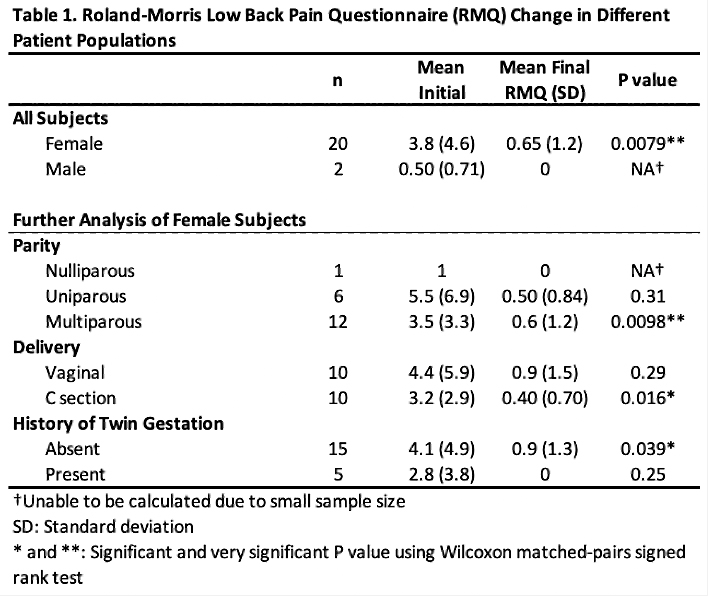Back Pain According to Roland-Morris Low Back Pain Scale Following Abdominoplasty With Plication: a Prospective Case Series
Sneha Patel1, Jing Xu1, Armin Palic1, Jacob Wood1, Eleanor Tomczyk2, Douglas Rothkopf1
1UMass Chan Medical School, Division of Plastic Surgery2Massachusetts General Hospital, Division of Plastic and Reconstructive Surgery
Background: Chronic back pain is a debilitating condition affecting more than 80% of adults in the United States. Despite many treatment options, chronic low back pain is multifactorial and difficult to manage. A recent case series highlighted the benefits of abdominoplasty on chronic back pain. Their results have been corroborated by an Australian prospective case series using the Oswestry Disability Index, which excluded male and nulliparous subjects. Our group aims to investigate the effect of abdominoplasty on back pain in a more diverse population using a different, non-interchangeable Roland-Morris Low Back Pain and Disability Questionnaire (RMQ).
Methods: Subjects over 18 years old who are undergoing radical abdominoplasty with plication are recruited. Subjects are given an initial survey inquiring the history of back pain and back surgery, in addition to current level of back pain. Past medical history including body mass index (BMI), parity and prior cesarean section are documented through chart review. RMQ, a highly sensitive questionnaire for grading mild-to-moderate disability caused by chronic low back pain, is administered. Surgical information including weight resected and liposuction volume are recorded. A follow-up survey and RMQ is then given six months after surgery. Paired Wilcoxon Rank Sum test is used to compare RMQ scores before and after surgery.
Results: Thirty-nine subjects were enrolled, and 7 were lost to follow up. Twenty-two completed both initial and follow-up surveys. Of these 22, the average age is 47.8 (SD=9.3). Twenty subjects were female and 19 were postpartum. Ten subjects had a history of cesarean section, and five gave birth to twins. Sixteen reported initial back pain on the RMQ scale. Of these, 15/16 reported a decrease in RMQ after surgery, including male and nulliparous subjects (N=2). The mean initial RMQ score was 3.5 and the mean final RMQ score was 0.6, this difference was significant (p=0.0058). No significant change was observed in the subjects’ BMI before and after surgery, but 13/22 demonstrated a sustained decrease in BMI six months after surgery. No significant relationship was observed between weight resected, percent weight resected or liposuction volume and RMQ change. Sub-group analysis of female subjects demonstrated significantly decreased RMQ scores in subjects with a history of cesarean section delivery and multiparous births.
Conclusions: Abdominoplasty with plication significantly decreases self-reported back pain six months after surgery. Subjects with a history of multiparous birth and cesarean section benefited especially from this surgery.
Back to 2022 Abstracts

